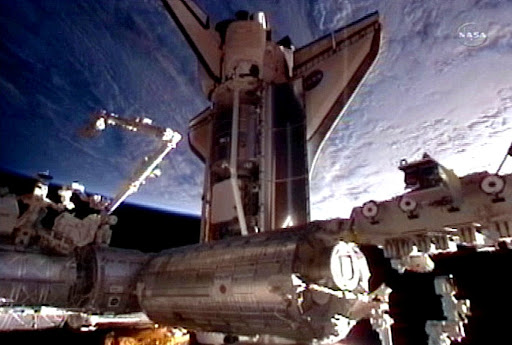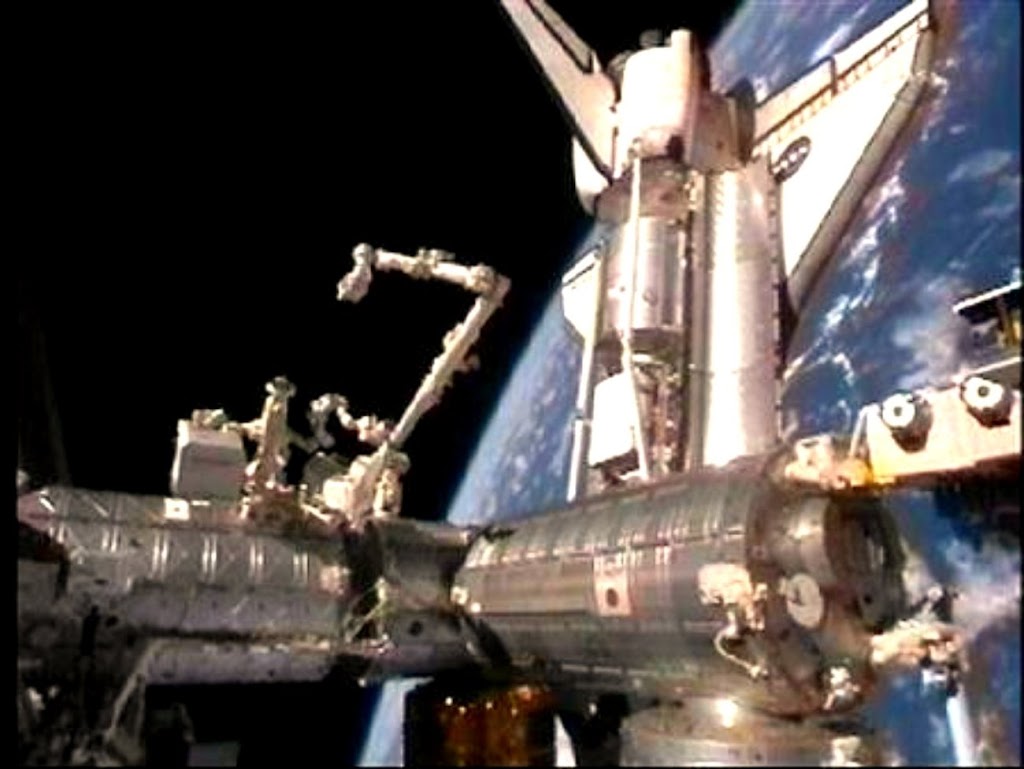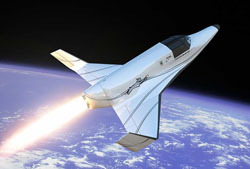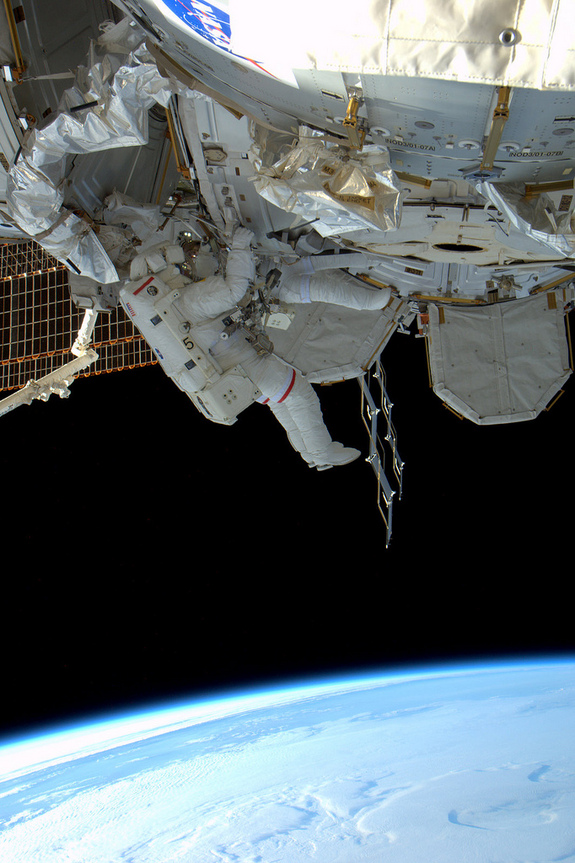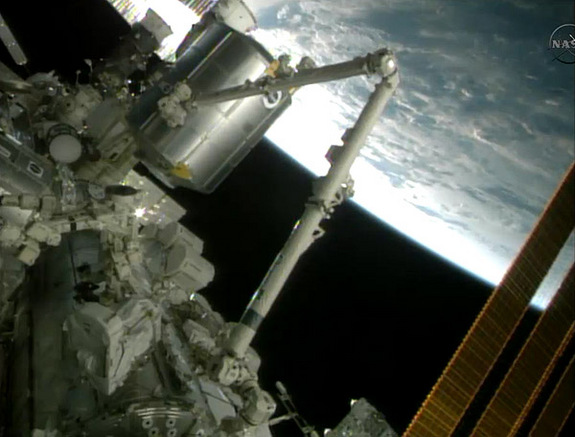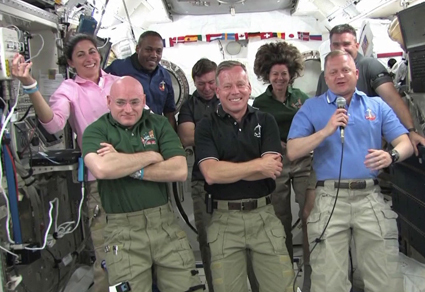MSNBC
Space shuttle Discovery blasts off on its final flight to the Intern. Space Station
Problem with range safety adds last-minute drama to space station mission
By msnbc.com staff and news service reports, Feb 24, 2011
 .
.FloridaToday:
Space shuttle Discovery’s final flight > Video:
Discovery lifts off
Cape Canaveral, Fla. — After a last-minute glitch, the space shuttle Discovery lifted off Thursday on its final voyage, heading for the International Space Station with six astronauts and a humanoid robot. The countdown proceeded smoothly until there were just minutes left before liftoff. Range safety officers reported that their command system display wasn't working, which could have forced a halt to the count.
"Calm down," shuttle launch director Mike Leinbach told his colleagues. He asked for some extra time to get the problem fixed — and received the go-ahead. The countdown was held at T-minus-5 minutes, but the range safety system was fixed with just seconds left to make Thursday's launch window. It was an extra bit of drama for a mission that was initially scheduled to launch in November. At that time, fueling problems held up the launch, forcing months of repairs. "Enjoy the ride," mission control told Discovery commander Steven Lindsey. "For those watching, get ready to witness the majesty and power of Discovery as she lifts off one last time," Lindsey replied.
The launch came at 4:53 p.m. ET, three minutes later than scheduled. Discovery is NASA's most traveled space shuttle, putting in nearly three decades of service. Now it's slated to become the first shuttle to retire. The shuttle is heading to the International Space Station with a load of supplies, a new orbital closet and a humanoid robot. This is the 39th flight for Discovery, which has logged 143 million miles (230 million kilometers) since its first mission in 1984. After retirement, the orbiter is expected to go on display at the Smithsonian Institution's Udvar-Hazy Center, an annex of the National Air and Space Museum.
 .Meet NASA's first humanoid robot, now in space
- R2 will be the first humanoid robot in space. It is designed to show how dexterous robots cope in a weightless environment
.Meet NASA's first humanoid robot, now in space
- R2 will be the first humanoid robot in space. It is designed to show how dexterous robots cope in a weightless environment
- After upgrades and advancements, Nasa hopes R2 can venture outside the space station to help astronauts on spacewalkers
- The expectation is that R2-like robots could one day go into orbit to service communications and scientific satellites
- Similar robots might be sent on deep space missions, where they would experience more extreme thermal and radiation conditions
- Humanoid robots could also help set up Mars camps before astronauts arrive, and maintain the surface experiments after they leave
NASA estimated that 40,000 guests were on hand for Discovery's farewell launch, including a small contingent from Congress. Watching with special interest from Mission Control in Houston is astronaut Timothy Kopra, who was supposed to be the flight's lead spacewalker. He was hurt in a bicycle crash last month and was replaced by Stephen Bowen, who will become the first astronaut to fly back-to-back shuttle missions. The other crew members include Lindsey, pilot Eric Boe, spacewalker Benjamin Alvin Drew Jr. and mission specialists Michael Barratt and Nicole Stott. All six astronauts are veterans. Stott and Barratt served long-term stints on the space station in 2009.
Onlookers flock to watch launch
Well before dawn, recreational vehicles already lined nearby roads offering the best views of liftoff. Signs outside businesses and government offices in the neighboring towns of Cape Canaveral and Cocoa Beach offered words of encouragement. "The heavens await Discovery," one church proclaimed. Local grocery stores stocked up on extra red, white and blue cakes adorned with shuttle pictures. Camera batteries flew off shelves.Leinbach noted that it would be "tough" to see Discovery soar one last time. "What will be most difficult will be on landing day when we know that that's the end of her mission completely," he said.
Discovery will spend 11 days in orbit — on top of the 352 days it's already spent circling the planet — and will rack up another 4.5 million miles (7.2 million kilometers). Its list of achievements include delivering the Hubble Space Telescope to orbit, carrying the first Russian cosmonaut to launch on a U.S. spaceship, returning Mercury astronaut John Glenn to orbit, and bringing shuttle flights back to life after the Challenger and Columbia accidents. "She's been an amazing machine," Leinbach said Wednesday. "She's done everything we've asked of her."Discovery's crew will deliver and install a closetlike compartment full of space station supplies. The Italian-made module was named Leonardo, after the Italian artist/inventor Leonardo da Vinci.
Packed inside the compartment is Robonaut 2, or R2, set to become the first humanoid robot in space. The experimental machine — looking human from the waist up — will remain boxed until after Discovery departs. Up at the space station, meanwhile, the six-person crew welcomed a European cargo ship that was launched last week from French Guiana. It docked successfully just six hours before Discovery's planned liftoff, keeping the shuttle countdown on track. "Busy day in space," station commander Scott Kelly noted in a Twitter tweet. NASA is under presidential direction to retire the shuttle fleet this summer, let private companies take over trips to orbit and focus on getting astronauts to asteroids and Mars. There's been considerable disagreement among lawmakers and the space community on how best to accomplish this.
 .
.BBC:
Space shuttle Discovery last flight
- The US Discovery has launched from the Kennedy Space Center for the last time.
- It is named after various historic vessels, including James Cook's 18th Century explorer
- Discovery was the first spacecraft to retrieve a satellite and bring it back to Earth
- It has completed more missions than any other vehicle in the space shuttle fleet
- The shuttle visited both the Russian Mir station and the International Space Station
- It carried the Hubble Space Telescope into orbit and made two servicing missions
- Total in orbit time: 352 days; Number of orbits: 5,628; Individual crewmembers: 180
"Godspeed Discovery," retired space shuttle program manager Wayne Hale said in a Twitter update Thursday. "Prayers for a safe flight and wisdom for decision makers."
 .> LiveStream: Shuttle take off
.> LiveStream: Shuttle take off .GMC: Space shuttle Discovery's final mission
.GMC: Space shuttle Discovery's final mission 








